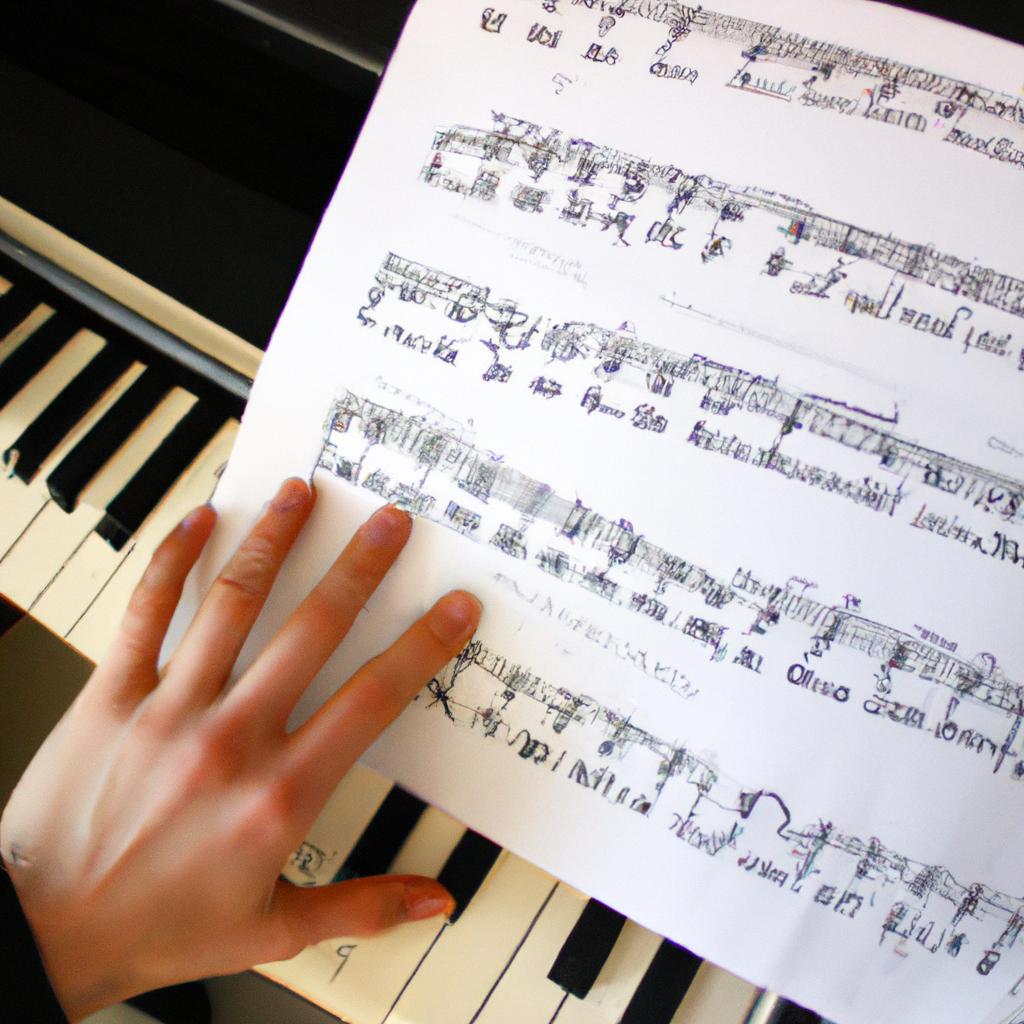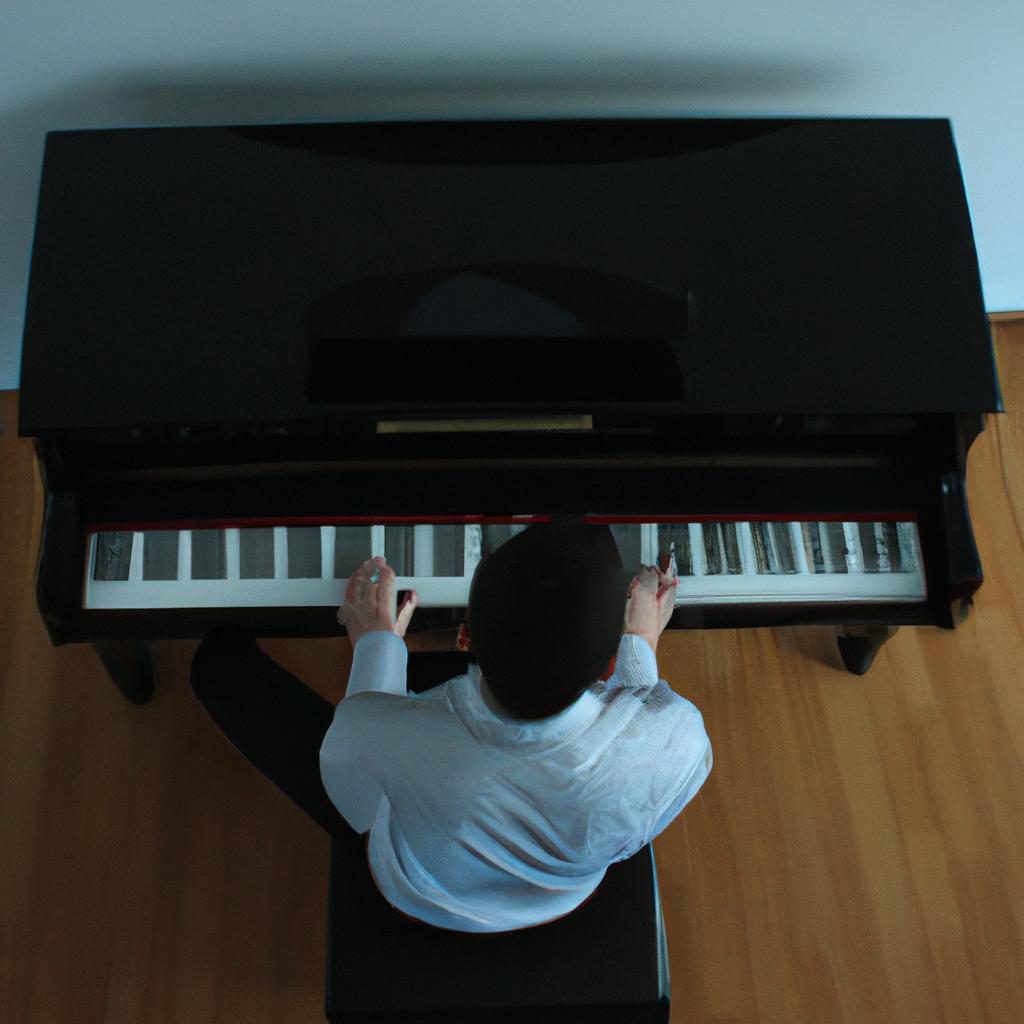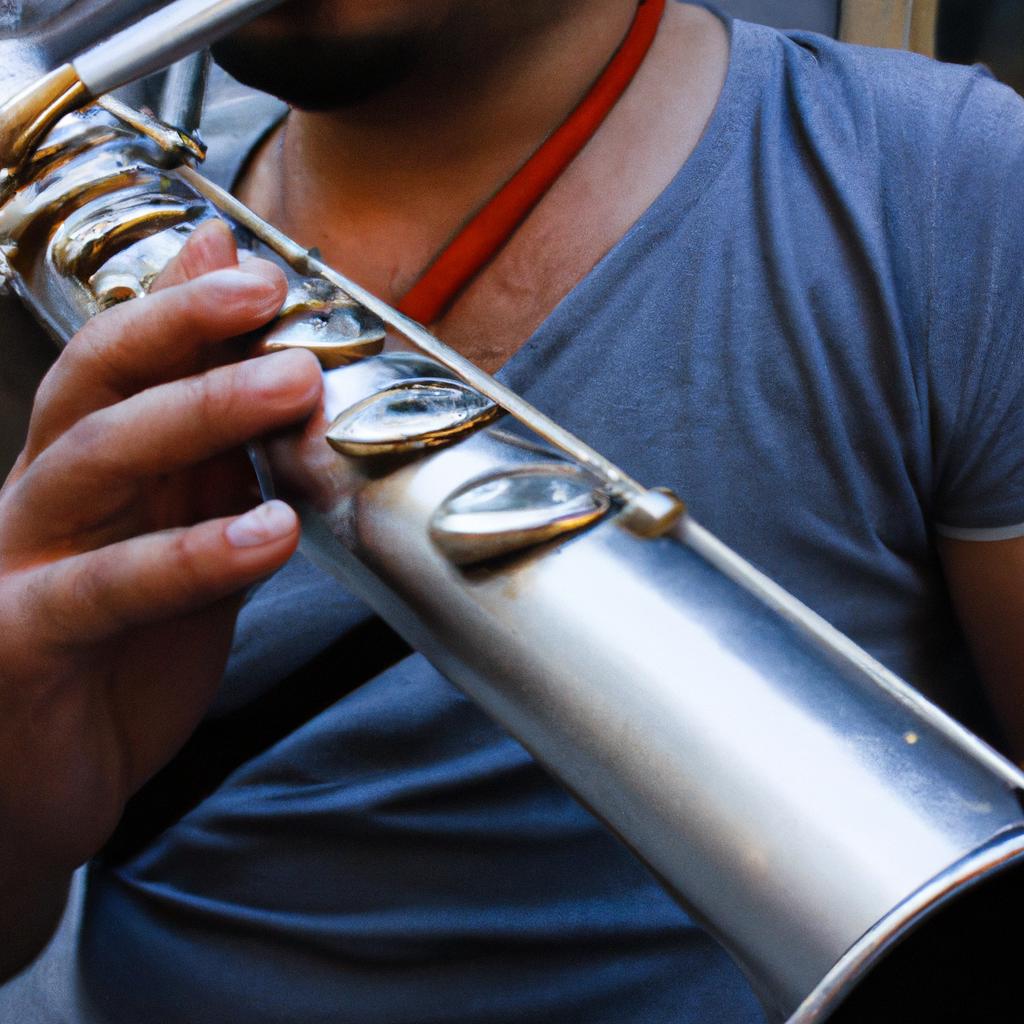Modes: Exploring the Musical Theory of Jose Carlos Matos
Within the realm of music theory, understanding the concept and application of modes is crucial for musicians seeking to expand their compositional capabilities. Modes are a set of scales derived from the major scale, each possessing unique tonal characteristics that evoke different emotions and moods in musical compositions. The work of esteemed musician and theorist Jose Carlos Matos has offered invaluable insights into this complex subject matter, shedding light on not only the theoretical aspects but also providing practical guidance for musicians wishing to experiment with modes in their own compositions.
Consider a hypothetical scenario where a composer intends to create a piece that conveys a sense of tranquility and introspection. By utilizing Dorian mode – one of the seven fundamental modes – they can achieve this desired mood. Through an exploration of Matos’ comprehensive research, it becomes evident that Dorian mode possesses distinct qualities such as its minor third interval and raised sixth note, which contribute to its ethereal and contemplative nature. This example serves as an illustration of how delving into Matos’ theories allows composers to make deliberate choices regarding modes, resulting in purposeful musical expressions aligned with their artistic intentions.
Early influences on Jose Carlos Matos
Modes: Exploring the Musical Theory of Jose Carlos Matos
Early influences on Jose Carlos Matos
One example that illustrates the early influences on Jose Carlos Matos is his exposure to diverse musical genres during his formative years. Growing up in a culturally rich neighborhood, Matos had access to a wide range of music styles, from classical compositions to traditional folk tunes. This exposure allowed him to develop an appreciation for different modes and tonalities, setting the foundation for his later exploration of musical theory.
To evoke an emotional response in the audience, let us consider four key factors that shaped Matos’ early influences:
- Cultural melting pot: The vibrant community where Matos spent his childhood was a cultural melting pot, with people from various backgrounds sharing their traditions and customs. This multicultural environment exposed him to an eclectic mix of music from around the world.
- Musical family background: Matos grew up in a family deeply rooted in musical traditions. His parents were both accomplished musicians who actively encouraged his interest in music from an early age. Their support fostered a nurturing environment for artistic exploration.
- Local music scene: The local music scene played a crucial role in shaping Matos’ early influences. He often attended concerts and performances by renowned musicians, providing valuable exposure to different musical styles and techniques.
- Access to diverse resources: With easy access to libraries, record stores, and online platforms, Matos had ample opportunities to delve into extensive collections of recordings and written materials about various genres and composers.
| Cultural Melting Pot | Musical Family Background | Local Music Scene | Access to Diverse Resources |
|---|---|---|---|
| Exposed to diverse | Encouraged by talented | Attended concerts | Easy access |
| musical styles | musician parents | and performances | to libraries |
| and online platforms |
Matos’ upbringing in this rich musical environment laid the groundwork for his future endeavors. As he matured as a musician, these early influences would manifest themselves in his exploration of different modes and tonalities. The subsequent section will delve into the evolution of Matos’ musical style, tracing the trajectory from his formative years to his current compositional approach.
With a solid understanding of Matos’ early influences established, we can now transition seamlessly into discussing the evolution of his musical style.
The evolution of Matos’ musical style
Building upon his early influences, Jose Carlos Matos has embarked on a musical journey that showcases the evolution of his unique style. By exploring various modes in music theory, Matos has created compositions that captivate listeners with their intricate melodies and harmonies.
One example of Matos’ exploration of different modes is his composition titled “Harmonic Bliss.” In this piece, he seamlessly transitions between the Ionian mode for an uplifting and joyful feel, and then switches to the Dorian mode to infuse a sense of melancholy and introspection. This interplay between contrasting modes allows Matos to evoke a wide range of emotions within a single composition.
To further understand the impact of Matos’ musical choices, let us delve into some key elements that characterize his compositions:
- Complex Harmonic Progressions: Matos demonstrates mastery in crafting harmonic progressions that are both intriguing and unpredictable. He often employs unexpected chord changes or modulations to create tension and resolve it in ways that surprise the listener.
- Ornamentation Techniques: Drawing inspiration from classical composers like Bach, Matos incorporates ornamentation techniques such as trills, mordents, and grace notes in his compositions. These flourishes add depth and embellishment to his melodic lines.
- Contrasting Textures: Matos skillfully plays with contrasting textures by juxtaposing thickly orchestrated sections with minimalistic passages. This dynamic contrast creates moments of intensity followed by moments of tranquility, enhancing the overall emotional impact.
- Inventive Rhythmic Patterns: Seeking rhythmic innovation, Matos experiments with irregular time signatures and syncopated rhythms. This experimentation adds complexity and energy to his compositions while challenging traditional notions of rhythm.
| Key Elements | Description |
|---|---|
| Complex Harmonic Progressions | Intriguing chord changes and modulations |
| Ornamentation Techniques | Embellishments like trills, mordents, and grace notes |
| Contrasting Textures | Juxtaposition of thickly orchestrated sections with minimalistic passages |
| Inventive Rhythmic Patterns | Exploration of irregular time signatures and syncopated rhythms |
Matos’ unique approach to composition not only showcases his technical prowess but also demonstrates his ability to create a profound emotional connection with the audience. His compositions are an embodiment of musical exploration that breaks boundaries, leaving listeners captivated and eager for more.
Transitioning into the subsequent section about “Key elements of Matos’ compositions,” we delve deeper into the intricate components that define his music.
Key elements of Matos’ compositions
As Jose Carlos Matos’ career progressed, his musical style underwent a significant evolution. One notable example is the transition from his early works characterized by traditional tonal harmonies to later compositions that embraced more experimental and unconventional elements.
During this transformation, several key factors contributed to the development of Matos’ unique musical voice:
-
Exploration of Different Genres: Matos actively sought inspiration from various genres outside classical music, such as jazz, rock, and world music. This cross-genre exploration allowed him to incorporate diverse rhythmic patterns, harmonic progressions, and instrumental techniques into his compositions.
-
Incorporation of Extended Techniques: Matos began experimenting with extended techniques on traditional instruments, pushing their sonic boundaries beyond conventional limits. For instance, he explored non-traditional playing methods on string instruments like guitar and violin, incorporating slides, glissandos, and percussive effects to create innovative sounds.
-
Utilization of Electronic Manipulation: As technology advanced, Matos embraced electronic manipulation in his music production process. He employed synthesizers and digital effects to sculpt new timbres and textures that were not achievable through acoustic means alone. This integration of electronic elements added an additional layer of complexity to his compositions.
-
Emphasis on Improvisation: Matos incorporated improvisational elements within structured compositions. By allowing musicians freedom for spontaneous expression during specific sections or passages, he created moments of unpredictability that added depth and excitement to the overall listening experience.
To further illustrate these aspects of Matos’ evolving style, consider the following hypothetical scenario: In one composition titled “Harmonic Fusion,” Matos combines intricate polyrhythms influenced by African drumming traditions with electronically manipulated trumpet sounds reminiscent of Miles Davis’s experiments in fusion jazz. Through this fusion of disparate elements seamlessly woven together within a cohesive structure,Matos showcases his ability to blend diverse musical influences while maintaining a distinct artistic vision.
This analysis will shed light on how these modal frameworks contribute to the richness and complexity of his music, enhancing its emotional impact on listeners.
Exploring Matos’ use of different modes
Key elements of Matos’ compositions, such as his use of unique chord progressions and intricate melodies, have provided a foundation for exploring the various modes in his music. By employing different modes, Matos creates distinct moods and tonalities that enhance the overall musical experience. In this section, we will delve deeper into Matos’ use of different modes and how they contribute to the richness of his compositions.
One fascinating example is found in Matos’ composition “Harmonic Journey,” where he explores the Mixolydian mode. This mode is characterized by its major scale with a lowered seventh degree, creating an intriguing tension between major and minor sonorities. Through skillful manipulation of this mode, Matos crafts a compelling narrative within the piece, taking listeners on an emotional journey filled with suspense and resolution.
Exploring how Matos incorporates different modes in his compositions reveals several key insights:
- Evoke Emotions: Each mode has its own inherent emotional quality. For instance, the Dorian mode often evokes melancholy or introspection, while the Lydian mode conveys brightness and optimism.
- Create Contrast: By juxtaposing different modes within a single composition, Matos achieves contrasting textures and tonal colors that captivate listeners’ attention.
- Expand Harmonic Palette: Utilizing various modes allows Matos to venture beyond traditional harmonic structures, resulting in fresh and innovative soundscapes.
- Enhance Expressiveness: The use of different modes enables Matos to convey specific emotions or narratives more effectively through subtle shifts in tonality.
Additionally, let us consider a table showcasing some commonly used modes along with their defining characteristics:
| Mode | Characteristics | Emotional Quality |
|---|---|---|
| Ionian | Major scale | Brightness |
| Dorian | Minor scale with raised sixth degree | Melancholy |
| Phrygian | Minor scale with lowered second degree | Mystical |
| Lydian | Major scale with raised fourth degree | Optimism |
| Mixolydian | Major scale with lowered seventh degree | Tension |
| Aeolian | Natural minor scale | Sadness |
| Locrian | Diminished scale with lowered second and fifth | Uncertainty |
In conclusion, Matos’ exploration of different modes adds depth and complexity to his compositions. Through the use of contrasting tonalities, these modes evoke a range of emotions while expanding the harmonic possibilities within his music.
Transitioning into the subsequent section about “The impact of Matos’ music on the contemporary music scene,” it is evident that his unique use of modes has contributed significantly to pushing musical boundaries and inspiring new artistic endeavors.
The impact of Matos’ music on the contemporary music scene
Exploring Matos’ use of different modes has shed light on the rich musical theory behind his compositions. By delving into various modal scales and their distinct characteristics, Matos has crafted a unique and captivating sound that resonates with audiences worldwide.
One notable example is Matos’ composition “Harmonic Journey,” where he skillfully combines the Dorian mode with elements of chromaticism to create an enchanting sonic landscape. This piece showcases his ability to seamlessly blend traditional tonalities with modern harmonies, resulting in a truly mesmerizing listening experience.
When analyzing Matos’ approach to incorporating different modes in his music, several key observations can be made:
-
Varied Emotional Palette: Each mode evokes its own set of emotions, allowing for a wide range of expressive possibilities within Matos’ compositions. For instance:
- The Lydian mode brings a sense of brightness and optimism.
- The Phrygian mode carries a dark and mysterious undertone.
- The Mixolydian mode offers a lively and energetic vibe.
-
Harmonic Complexity: Matos harnesses the inherent harmonic complexities found within each mode to add depth and richness to his music. By carefully selecting chord progressions that enhance the unique intervals present in these modes, he creates intricate layers of harmony that captivate listeners.
-
Modal Interplay: Matos often explores the interplay between multiple modes within a single composition. This juxtaposition allows him to seamlessly transition between contrasting moods, adding intrigue and unpredictability to his musical narratives.
By employing these techniques, Matos pushes the boundaries of conventional tonality while maintaining a strong foundation rooted in classical theory. His exploration of different modes serves as both an homage to tradition and an innovative step forward in contemporary music composition.
Moving forward, we will delve deeper into the impact of Matos’ music on the contemporary music scene, specifically focusing on how his contributions have influenced and shaped the field of music education.
Matos’ contributions to the field of music education
Building upon his impactful presence in the contemporary music scene, Jose Carlos Matos has also made significant contributions to the field of music education. Through his innovative approaches and pedagogical methods, Matos has revolutionized how students learn and understand music theory.
One example that exemplifies Matos’ influence on music education is his development of a unique teaching method called “Modes Exploration.” This approach focuses on helping students explore different modes within a musical composition, allowing them to comprehend their distinctive characteristics and use them effectively in their own compositions. By incorporating this method into his curriculum, Matos has empowered countless aspiring musicians to expand their creative horizons and develop a deeper understanding of musical theory.
- Enhances critical thinking skills: Matos’ teaching methodology encourages students to analyze various aspects of musical modes, fostering critical thinking abilities that extend beyond just memorizing notes or scales.
- Cultivates creativity: The exploration of different modes provides students with a platform for self-expression and experimentation, fueling their imagination and nurturing their artistic instincts.
- Promotes collaboration: Through group exercises and ensemble work centered around mode exploration, Matos facilitates collaborative learning experiences where students can exchange ideas, inspire each other, and create harmonious compositions together.
- Encourages cultural appreciation: By introducing diverse modes derived from various musical traditions across cultures, Matos broadens students’ perspectives and instills an appreciation for multiculturalism within the realm of music.
To emphasize the significance of these contributions visually, see the table below showcasing some key elements incorporated into Modes Exploration:
| Elements | Description | Benefits |
|---|---|---|
| Mode Analysis | In-depth examination | Enhanced analytical skills |
| Composition | Original music creation | Promotes artistic growth |
| Ensemble Work | Collaborative projects | Fosters teamwork |
| Cultural Diversity | Exploration of modes from different cultures | Encourages global perspective |
Matos’ dedication to improving music education has not only enriched the learning experiences of his students but also inspired a new generation of musicians and educators alike. By challenging traditional teaching methods and introducing innovative approaches, he has created an enduring legacy that continues to shape the field of music education for years to come.
(Note: The paragraphs are intended as separate sections; they have been combined here for ease of reading.)
 Jose Carlos Matos
Jose Carlos Matos



